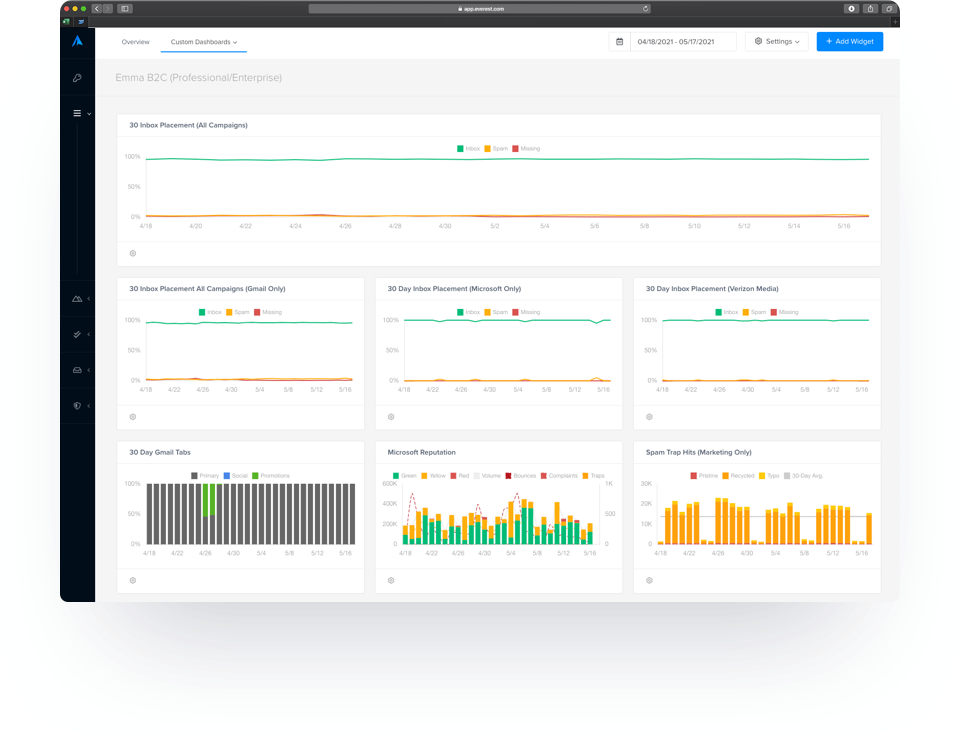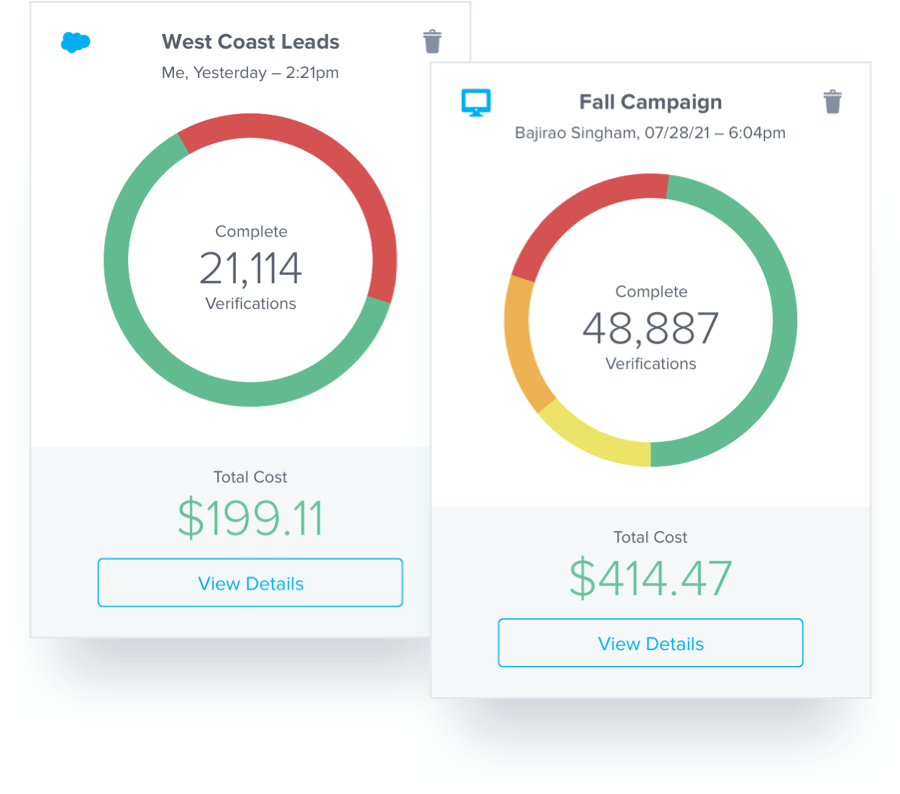By analyzing email open rates, your business can determine the answers to important questions, such as:
- Is your audience not only receiving your emails but also opening and reading your messages?
- How does your open rate competitively compare to others in your industry?
- How can your email open rates improve?
Read on to learn the answers to these questions, as well as the ins and outs of email open rates.
What is an email open rate?
It’s also important that your team understands exactly what counts as an “opened” email. For most rates, the general understanding is that your subscriber interacted with your email in one of two ways:
- Your subscriber enabled images to load in their inbox. If they open your email and any images load, your team can track when that happens.
- Your subscriber clicked a link within the email.
Since these two methods don’t encompass every possible way your audience may have interacted with your email, the email open rate is actually an estimate — albeit a helpful one.
94%
Increase in inbox volume from 2020 to 2021 during the pandemic, making it more and more challenging to keep email recipients engaged

With your unique email open rate, your marketing team can build goals and strategies to improve how you connect with your target audience. By understanding how many people see your emails and choose to click and engage with them, your team will be able to determine what content is most relevant to your audience and what content does not resonate.
However, recently more and more mail clients and mailbox providers are protecting privacy at the expense of valid open rate data. In June 2021, Apple announced its plans to introduce Mail Privacy Protection (MPP) for its native Mail client users. This feature prevents email senders from using tracking pixels to measure open rates. Due to this, open rates are better viewed on a channel-by-channel basis, rather than overall.
How to calculate your email open rate
A standard way to calculate your campaign’s email open rate is to use the following formula:
Number of Emails Opened / Number of Delivered Emails ×100 = Email Open Rate
Discover how Everest can help your email marketing campaigns succeed.

What is the industry average email open rate?
Once you’ve figured out the email open rates for your company’s campaigns, you’ll have a good understanding of where you stand within your own standard. However, it’s also critical to take into account what the average email open rate is for your industry.
When you compare your email open rates, you can determine what campaigns were most effective within your mailing list. But without the average email open rate, you won’t be able to discern whether your open rates are good or bad within your market. Comparative metrics are essential to understanding your company’s personal metrics.
Read the average email open rates for the below industries as of 2020, according to the DMA Benchmark Report:
Average email open rates by industry as of 2020, according to the DMA:
| Industry | Average open rate: |
| Finance | 21% |
| Retail | 19.5% |
| Publishing | 15.4% |
| Travel | 21.1% |
| Not for Profit | 26.1% |
| Utilities | 24.6% |
| B2B, overall | 20.5% |
| B2C, overall | 19.8% |
| Average Totals | 20.94% |
A higher open rate percentage is also a good indicator that your subject lines are effective. The more relevant and engaging your subject lines are, the more likely your email list will choose to open your messages.
Learn more about improving open rates and other key metrics with Validity’s Guide to Email Marketing Metrics

How to improve your email open rates
- Is the subject line enough to capture your audience’s attention?
- Does your mailing list contain valuable subscribers?
- How many campaigns are too many or too few for your strategy?
Once you have these answers, your team can start to focus on other means to achieve good open rates. Consider the options below to make sure your team is following the best and most proven methods to increase your open rates.
Send your emails at the right time and day
Some articles may tell you that the best industry open rates are on Tuesdays and Thursdays, or that you should avoid Mondays and Fridays because people aren’t always in the office. Similarly, they might advise that the best window of time for users to see your emails is mid-morning. However, the best time to send emails is when your customers are most likely to engage with them — and this is best identified by analyzing your data.
Your team should take into account your own metrics based on your unique customer base. Aim to follow the general best days and times for your campaigns, but don’t be afraid to adjust your schedules according to your own audience’s feedback. Reschedule your emails for different times and days to figure out exactly when your campaigns can reach peak success.
Clean your lists of unengaged subscribers
If your email campaigns contain an increased or high amount of bounces and undelivered emails, it’s time to clean up your mailing list. Bounces can be the result of invalid or mistyped emails (whether accidental or on purpose) — they will clutter your data and hurt your sender reputation. Deliverability is a top priority for your marketing team to actually reach your active audience.
Email verification software such as Validity’s BriteVerify can validate your mailing list to make sure that you’re reaching active subscribers. Faulty email addresses waste valuable time and resources, so it’s important to ensure your mailing lists are updated to increase productivity. By cleansing your email database, you can ensure that you are only sending campaigns to valid addresses.
Learn more about how Validity BriteVerify can help you clean your email lists.

Segment your lists
Not only should your mailing lists be comprised of verified subscribers, but it’s also best practice to segment your lists to target specific audiences. For example, you may choose to segment your campaigns based on demographics, user engagement, buying behavior, or other factors relevant to your business. By doing this, you can vastly improve your email open rates because each campaign will have your specific audience factored into the content.
Extra tip:
Avoid segmenting your audience into too many subcategories. If your list is too small, your team will probably spend more time than is needed on too narrow of an audience. Segmentation allows you to target specific subscriber groups, but they should still be broad.
Optimize subject lines
Avoid long or drawn-out subject lines with complicated words or concepts. Instead, aim for an approximately 10-word sentence that’s catchy and — most importantly — relevant to the content of your email.
“Using ‘How are you?’ in the subject line triggered an open rate of 80%. The marketing team was convinced it was far too simplistic and would not work.”
Get past the SPAM filters
Instead of avoiding certain words, make sure that you’re sending your campaigns from verified IPs or domains with good sender reputations. If your sender reputation is low, you’re more likely to end up in the spam folder, or even worse, find yourself on a blocklist.
You can also ask your new subscribers to allowlist your emails in your welcome messages to them. This way your emails can avoid getting stuck in spam folders.
9%
Decrease in average inbox placement, thanks to mailbox providers tightening their filtering algorithms
5%
Decrease in average open rates, with inbox volume almost doubling and recipients becoming more selective
Effectively use the ‘From’ field
If your business has email campaigns that are specific to newsletters or to transactional emails, create separate subdomains to ensure your users know what type of email they’re receiving.
Make your preview text work for you
Avoid using the preview text to greet the reader (ex. “Hello, reader…”) and instead sum up your content with a short and relevant message. If your subject line hasn’t convinced your audience to open your email, the preview text is your next opportunity to grab their attention.
Personalize your emails
Including a subscriber’s first name in the subject line increases email click-through rates compared to not doing so. This confirms that personalized emails are more likely to improve your open rates.
By emphasizing a content strategy that focuses on the subscriber as an individual — using their names, emojis or friendly copy — your emails will find higher success rates with your audience.
Pay attention to the number of emails you send
The best tip to retain customer attention and loyalty is to create and follow an email marketing calendar. By tracking your past, present and future emails, you can note exactly how often you’re reaching out to subscribers and adjust your schedule based on engagement data.
Validity can help improve your email open rates
Email is one of the best marketing tools for businesses across any industry. In fact, according to the DMA Marketer Email Tracker report, an email address is one of your most valuable assets with an average customer lifetime value of $50 and earning $42 for every $1 spent. Compelling email marketing campaigns are the best ways to create long-lasting relationships with your audience. But how do you get your subscribers to actually receive and open your emails?
It’s critical that your emails not only reach your target audience’s inboxes but also that they’re opened. After all, the higher the email open rate, the more likely your subscribers will engage with your content. Learn more about the best practices we recommend for email campaigns here.
With Validity’s services, your business can start optimizing your email marketing campaigns to improve email open rates through increased deliverability, content optimization, comparative metrics and more.
Contact us today to schedule a free demonstration and see how our programs and services can help improve your email open rates and encourage audience engagement.
Contact us today to schedule a free demonstration and see how Validity can improve your email open rates and encourage audience engagement.
